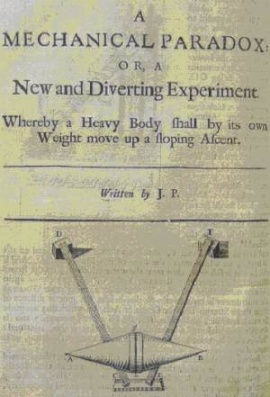Gravitational Interactions on the Surface of a Pseudosphere
- bhlavenda
- Mar 23, 2024
- 3 min read
Updated: Jul 17, 2024
Apart from being a model of the hyperbolic plane introduced by Eugenio Beltrami in the mid nineteenth century, the double cone, obtained by sticking together two pseudospheres at their ends, found interest as an uphill roller defying gravity more than a century and a half earlier.
William Leybourn in his recreational volume, Pleasure and Profit, published in 1694

describes how a double cone when placed on two inclined rails

will actually roll uphill when the angle of inclination of the ramp upon which the double cone is placed, and free to roll, is large. For it then behaves as a double cone defying gravity, while as it decreases the double cone becomes essentially a cylinder and rolls downhill. So eventhough the center of gravity moves downward, the double cone will ascend the ramp at large angles.
This could have been used as an argument on how geometry and gravity interact, although in this case it would give a surprising result of "gravitational repulsion". So it would be interesting to see what are the gravitational interactions that a body will display when constrained to move on the surface of a pseudosphere.
General Relativity goes to great lengths to show how masses can create indentions in a stretched membrane, such as a trampoline. Mathematically speaking, we can consider the embedding from Euclidean space, R^3, onto a curved space. However, since the pseudosphere has constant negative curvature, the hyperbolic plane is too big for R^3. If we consider the half-plane model of hyperbolic geometry in 2D Euclidean space, we are forced to consider a sector of the hyperbolic plane of with 2 \pi c, where c is some constant in the x-direction and less than c in the y-direction. But rather than being a hindrance, it is an attribute since the cut-off, c, will provide a criterion of validity of hyperbolic geometry as we shall now see.
Consider the metric of a flat cylinder of radius, r, and height, h:
ds^2= dr^2 +r^2 d\phi^2+ dh^2. (1)
Furthermore, let us introduce the constraint.
dr^2 + dh^2 =d\rho^2, (2)
where \rho is logarithmic distance,
\rho= R\ln r/R, (3)
where R will play the role of the constant c above.
Introducing (3) into (2) gives
dh^2=(1-r^2/R^2) dr^2. (4)
Taking the negative square root gives the equation of a tractrix,
dh/dr= - \srqt[1-r^2/R^2]/r, (5)
Revolving the tractrix along its long axis gives a pseudosphere. Consequenty, the constraint (2) on the cylinder (1) gives rise to a 2D metric of constant curvature,
ds^2 = d\rho^2 + R^2 e^(2\rho/R) d\phi^2. (6)
It is well-known that
ds^2 = d\rho^2 + R^2 \sinh^2(\rho/R) d\phi^2 (7)
describes the hyperbolic plane, which can be considered as the imaginary radius of a sphere with surface metric,
ds^2 =d\rho^2 + R^2\sin^2(\rho/R) d\phi^2. (8)
Nevertheless, (6), has negative constant curvature, the same as (7).
Now, Newton's inverse square law imposes the force in R^3 as proportional to the inverse of the surface area 4\pi r^2 of a sphere. The natural extension to the hyperbolic plane would be to replace the surface area element by 4 \p R^2 \sinh^2(\rho/R), as (7) would propose. But, (6) would give the area swept out by a double radius, 2\rho, in an arc R\Delta\phi as
\Delta A= \Delta\phi \int_0^(2\rho) R e^(x/R) dx= \Delta\phi 2R^2{e^(2\rho/R)-1}
or
dA/d\phi = R^2\sinh(\rho/R) e^(\rho/R) (9)
The rate of change of the area with respect to time would be
dA/dt=dA/dphi d\phi/dt = R^2 \sinh(\rho/R) e^(\rho/R) d\phi/dt =2h (10)
where h is the conserved angular momentum.
Thus, instead of Newton's law for the acceleration,
a = GM/R^2 \sinh^2(\rho/R) (11)
in the hyperbolic plane, which would reduce to his law in R^3 in the limit R>>\rho, we
now have
a =GM e^(-\rho/R)/R^2\sinh(\rho/R). (12)
In the asymptic limit, R>>\rho, we get
a -> GM e^(-\rho/R) / R\rho (13)
which is an inverse-law rather than being an inverse-square law.
Equation (3) is exactly what MOND predicts for rotational curves of spiral galaxies of extremety low centripetal accelerations. There, everything is lumped into the single parameter, a_0, in
a =\sqrt[GMa_0]/ \rho. (14)
A comparison with (13) gives Milgrom's parameter as
a_0=GM/R^2 e^(-2\rho/R). (15)
The exponential factor results from a shielding by other masses. Since a_0 is proportional to the total luminosity, L. of the galaxy, (15) would predict an exponential decay of the luminosity with logarithmic distance, \rho, or an inverse-square law for the distance, r,
a_0= GM/ r^2,
according to (3). Thus, it is the logarithmic scale of distance which is used on the pseudosphere causing an exponential decrease in luminosity, whereas it decays as a function on the inverse-square of the distance in terms of r, as one would normally expect.

Comments